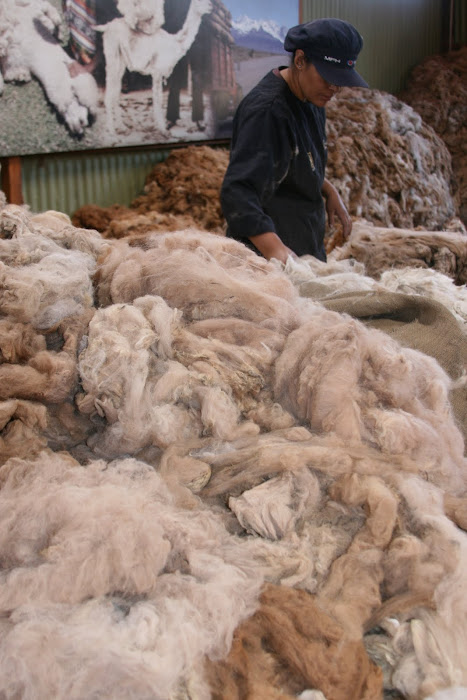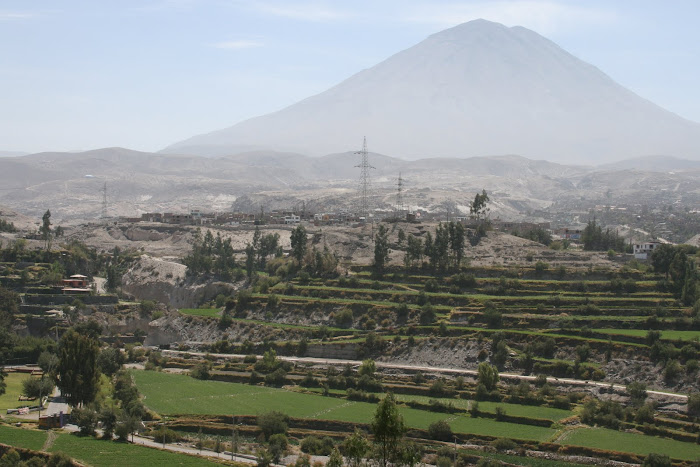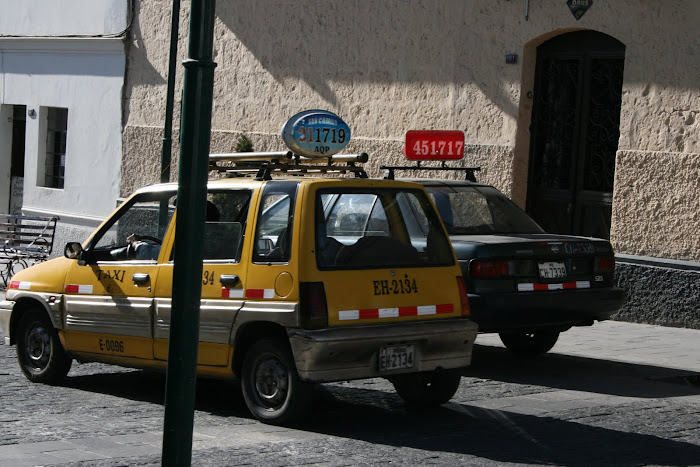Travel Diaries : Sep 30I didn't take to Arequipa too well initially. Flew into the city feeling woozy and extremely tired. Before I knew it I was hit by a severe bout of nausea and I worried myself sick if it could be the altitude. Luckily plenty of water and a good hours sleep proved to be all that I needed...
We were soon out exploring the white city, gorgeous in every way. The city sits on the Andes mountains at a height of 2380 m. In search of restaurants we roamed Jerusalem street on the look out for Peruvian food.
The most famous dish in Peru is
'Ceviche'. Though traditionally made of fish, there are several variants available. I was lucky enough to sample some of the Vegetarian alternatives. :)
 | | 'Plaza De Armas' , the main plaza with the Cathedral in the background |
|
Strolling along the Main Square , we sat watching people feed pigeons. We were to discover that this was a ritual in most Peruvian cities. The Plaza was bustling with activity, and the laughter and noise was contagious. Ironic as it may seem , inspite of the hustle and bustle the plaza seemed to lull us into a certain sense of calm and we lingered on watching the crowds and soaking up the sights and sounds. It was a day for pictures, bright and sunny and absolutely gorgeous. The cathedral in the background is twin towered and was originally built in 1612. It was later rebuilt following damage by Earthquakes and a Fire and boasts of beautiful intricate woodwork on the insides
 | | The Ritual of 'Pigeon Feeding' |
|
The Plaza is surrounded by Cafes, restaurants and life in general seems to revolve around this splendid center - the pulsating heart of the city. All the buildings are built from
'Sillar' a white volcanic stone and hence the name
'White City'
"Many of the almost 250 colonial buildings entitled as Human Heritage by UNESCO, are close to the main square. Some are turned to banks, stores, restaurants and departments. This practical way of preserving the city by finding a practical use to the historical buildings, provides a great experience to the visitor who feels like visiting a living museum."
-
Wikitravel  | | The Fountain at the Plaza |
|
We spent the rest of the day discovering the town, resorting to our favourite pass time of tottering the streets.. There were numerous little cafes tucked away.
 | | Pretty Streets of Arequipa |
|
The traffic is just as choatic as it is in the Indian subcontinent. Small and weird reminders of home in a distant faraway :). The policemen intervene to regulate and decongest Arequipa's busy roads every now and then
 | | Policeman.. |
|
There are several tours on offer and we decided to try a city tour. It was a four hour ride taking us to various points within and a little away from the city and the open bus gave us vantage photographic points
 | | Saint Lazarus Neighbourhood |
|
The neighbourhood of Saint Lazurus , is held to be the most traditional in Arequipa. The place was built by Dominican Priests around 1538 and was to serve as the fulcrum of the evangelist movement. It served as a center to develop and build a new Spanish city. The entire neighbourhood is built with white stones , and is lined with quaint cobblestone streets. Inside is a cathedral (which we did not visit), and a market place named n honour of the general who first owned it. '
Pan De Ripacha' a special kind of bread made from wheat and baked on wood is something specially made only here.
 | | Life in Arequipa.. |
|
 | | Alpaca Sheering.. |
|
We visited a Alpaca shearing center. Alpacas are native to the land of Peru and closely resemble their cousins the Llama. Alpaca wool has been considered valuable since Inca times.
 | | Local Dance Form.. Men on Horses perform to the tune of vibrant peruvian music and finish off with cheers of 'Bravo Bravo' from onlooking spectators |
|
 | | Paucarpata Terraces with ,El Misti, volcano in the background |
|
We drove past the
'Paucarpata Terraces' which are now considered part of
'Peruvian Cultural Heritage'. The terraces serve as agricultural systems painstakingly built into the the rugged mountain sides by the people of the Andes(Pre Inca). Its amazing how advanced the people of this region were . Apart from the obvious function of preventing erosion, It has been established that the terraces served as sophisticated climate control mechanisms. The bigger stones were placed lower down and the smaller stones occupied the upper parts. This apparently trapped heat retaining it at night when temperatures fell . Vegetables like Potatoes, Corn, Onions were all grown here
 | | Volcanos around Arequipa.. |
|
Arequipa is surrounded by three volcanoes. The Largest '
El Misti' stands at 5822 m above sea level and is classified as a Active volcano. It last erupted in 1985 Geologists predict an erruption is due, but when thats something impossible to say. Its a strato volcano and is built by many layers of hardered lava. in 1998 there were many Inca mummies discovered on the top of this volcano.
El Misti lies between two other volcanoes Chachani (6,075 m) and Pichu-Pichu (5,669 m/18,599 ft).
The volcanoes can be seen from most places in the city and the snow covered peaks are a captivating sight.
 | | Local Taxis |
|
Afternoon we head out to see 'Santa Catalina' and 'Juanita' the Ice princess.
Later Guys,
M
i love the way the volcano hovers over the city.... reminds me of vesuvius overseeing naples!!! are u allowed to hike any of these?
ReplyDeleteThe volcanoes were so beautiful!.. You can see them from most parts of the city.. and its normally the first sight that greets you once you get off in the tiny little airport in Arequipa...
ReplyDeleteThere were plenty of treks on offer to hike up , or around the volcano